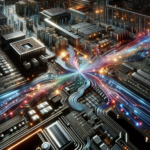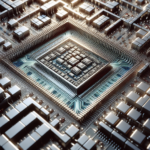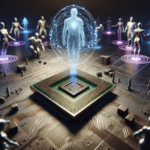The Role of CPUs in Machine Vision Systems

Introduction to Machine Vision Systems
Machine vision systems are a critical component in modern automation and robotics, enabling machines to interpret and understand visual information from the surrounding environment. These systems are used in a wide range of applications, from quality control in manufacturing to autonomous vehicles and medical imaging. At the heart of these systems lies the Central Processing Unit (CPU), which plays a pivotal role in processing and analyzing visual data.
The Role of CPUs in Machine Vision Systems
The CPU is the brain of any computing system, responsible for executing instructions and managing data flow. In machine vision systems, the CPU’s role is multifaceted, encompassing image acquisition, preprocessing, feature extraction, and decision-making. Let’s delve deeper into each of these aspects.
Image Acquisition
Image acquisition is the first step in any machine vision system. It involves capturing visual data from cameras or sensors. The CPU coordinates with these devices to ensure that images are captured at the right time and with the appropriate settings. This process often requires real-time processing capabilities, as delays can lead to inaccurate or outdated information.
Preprocessing
Once the images are acquired, they need to be preprocessed to enhance their quality and make them suitable for further analysis. Preprocessing tasks include noise reduction, contrast enhancement, and geometric transformations. The CPU performs these tasks using various algorithms, ensuring that the images are clear and consistent.
Feature Extraction
Feature extraction is a crucial step in machine vision systems, where specific attributes or patterns are identified within the images. These features could be edges, corners, textures, or shapes. The CPU uses complex mathematical algorithms to detect and extract these features, which are then used for further analysis and decision-making.
Decision-Making
After extracting relevant features, the CPU must make decisions based on the analyzed data. This could involve classifying objects, detecting anomalies, or guiding robotic actions. The decision-making process often relies on machine learning models, which require significant computational power to train and execute. The CPU’s performance directly impacts the accuracy and speed of these decisions.
CPU Architectures in Machine Vision Systems
Different CPU architectures offer varying levels of performance and efficiency for machine vision tasks. Understanding these architectures can help in selecting the right CPU for specific applications.
Single-Core CPUs
Single-core CPUs are the simplest form of processors, with a single processing unit. While they are sufficient for basic machine vision tasks, they may struggle with more complex and real-time applications due to limited processing power.
Multi-Core CPUs
Multi-core CPUs have multiple processing units, allowing them to handle multiple tasks simultaneously. This parallel processing capability makes them well-suited for machine vision systems that require real-time processing and analysis. Multi-core CPUs can significantly improve the performance and responsiveness of these systems.
Graphics Processing Units (GPUs)
While not strictly CPUs, GPUs are often used in conjunction with CPUs to accelerate machine vision tasks. GPUs are designed for parallel processing and can handle large volumes of data efficiently. They are particularly useful for tasks like image processing and machine learning, where they can offload some of the computational burden from the CPU.
Optimizing CPU Performance in Machine Vision Systems
To maximize the performance of machine vision systems, it is essential to optimize the CPU’s capabilities. Here are some strategies to achieve this:
Algorithm Optimization
Optimizing the algorithms used for image processing and analysis can significantly reduce the CPU’s workload. This involves selecting efficient algorithms, minimizing redundant computations, and leveraging hardware-specific optimizations.
Parallel Processing
Utilizing the parallel processing capabilities of multi-core CPUs and GPUs can enhance the performance of machine vision systems. This involves dividing tasks into smaller sub-tasks that can be processed simultaneously, reducing overall processing time.
Real-Time Operating Systems (RTOS)
Real-time operating systems are designed to handle time-sensitive tasks with minimal latency. Using an RTOS can ensure that the CPU responds quickly to real-time events, improving the performance and reliability of machine vision systems.
Hardware Acceleration
In addition to GPUs, other hardware accelerators like Field-Programmable Gate Arrays (FPGAs) and Application-Specific Integrated Circuits (ASICs) can be used to offload specific tasks from the CPU. These accelerators are designed for high-performance computing and can significantly boost the efficiency of machine vision systems.
Applications of Machine Vision Systems
Machine vision systems are used in a wide range of industries and applications. Here are some notable examples:
Manufacturing
In manufacturing, machine vision systems are used for quality control, inspection, and automation. They can detect defects, measure dimensions, and guide robotic arms with high precision, ensuring consistent product quality and reducing human error.
Autonomous Vehicles
Autonomous vehicles rely heavily on machine vision systems to navigate and make decisions. These systems use cameras and sensors to detect obstacles, recognize traffic signs, and monitor road conditions. The CPU processes this data in real-time to ensure safe and efficient driving.
Medical Imaging
In the medical field, machine vision systems are used for diagnostic imaging, surgical assistance, and patient monitoring. They can analyze medical images to detect abnormalities, guide surgical instruments with precision, and monitor vital signs in real-time.
Security and Surveillance
Machine vision systems are widely used in security and surveillance applications. They can detect and track objects, recognize faces, and analyze video feeds for suspicious activities. The CPU processes this data to provide real-time alerts and enhance security measures.
Challenges and Future Trends
While machine vision systems have made significant advancements, they still face several challenges. These include handling large volumes of data, ensuring real-time processing, and maintaining accuracy in diverse environments. However, ongoing research and technological advancements are addressing these challenges and paving the way for future trends.
Edge Computing
Edge computing involves processing data closer to the source, reducing latency and bandwidth requirements. By integrating powerful CPUs and GPUs at the edge, machine vision systems can achieve real-time processing and analysis, even in remote or resource-constrained environments.
Artificial Intelligence (AI) Integration
The integration of AI and machine learning with machine vision systems is a growing trend. AI algorithms can enhance the accuracy and efficiency of image processing and decision-making tasks. CPUs with AI acceleration capabilities are becoming increasingly important in this context.
5G Connectivity
The advent of 5G technology promises faster and more reliable connectivity, enabling seamless communication between machine vision systems and other devices. This can enhance the performance and scalability of these systems, particularly in applications like autonomous vehicles and smart cities.
FAQ
What is a machine vision system?
A machine vision system is a technology that enables machines to interpret and understand visual information from the surrounding environment. It involves capturing, processing, and analyzing images to make decisions or perform actions.
Why is the CPU important in machine vision systems?
The CPU is crucial in machine vision systems as it handles image acquisition, preprocessing, feature extraction, and decision-making. Its performance directly impacts the accuracy and speed of these tasks.
Can GPUs replace CPUs in machine vision systems?
While GPUs can significantly enhance the performance of machine vision systems, they cannot entirely replace CPUs. GPUs are designed for parallel processing and are best suited for specific tasks like image processing and machine learning. CPUs are still needed for general-purpose computing and managing overall system operations.
What are the challenges in machine vision systems?
Challenges in machine vision systems include handling large volumes of data, ensuring real-time processing, maintaining accuracy in diverse environments, and integrating with other technologies like AI and edge computing.
What are the future trends in machine vision systems?
Future trends in machine vision systems include the integration of edge computing, AI, and 5G connectivity. These advancements aim to enhance real-time processing, accuracy, and scalability of machine vision applications.
Conclusion
The role of CPUs in machine vision systems is indispensable, encompassing various tasks from image acquisition to decision-making. Different CPU architectures offer varying levels of performance, and optimizing these systems involves leveraging parallel processing, real-time operating systems, and hardware accelerators. As technology continues to evolve, future trends like edge computing, AI integration, and 5G connectivity promise to further enhance the capabilities and applications of machine vision systems. Understanding the critical role of CPUs in these systems is essential for developing efficient and reliable machine vision solutions.



